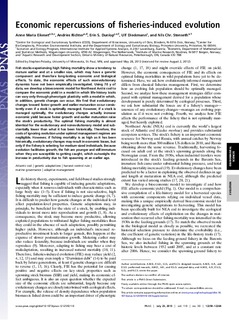| dc.contributor.author | Eikeset, Anne Maria | |
| dc.contributor.author | Richter, Andries | |
| dc.contributor.author | Dunlop, Erin S. | |
| dc.contributor.author | Dieckmann, Ulf | |
| dc.contributor.author | Stenseth, Nils Christian | |
| dc.date.accessioned | 2013-10-23T12:15:11Z | |
| dc.date.available | 2013-10-23T12:15:11Z | |
| dc.date.issued | 2013-07-23 | |
| dc.identifier.citation | Anne Maria Eikeset, Andries Richter, Erin S. Dunlop, Ulf Dieckmann, and Nils Chr. Stenseth Economic repercussions of fisheries-induced evolution PNAS 2013 110: 12259-12264. | no_NO |
| dc.identifier.uri | http://hdl.handle.net/11250/109189 | |
| dc.description.abstract | Fish stocks experiencing high fishing mortality show a tendency to mature earlier and at a smaller size, which may have a genetic component and therefore long-lasting economic and biological effects. To date, the economic effects of such ecoevolutionary dynamics have not been empirically investigated. Using 70 y of data, we develop a bioeconomic model for Northeast Arctic cod to compare the economic yield in a model in which life-history traits can vary only through phenotypic plasticity with a model in which, in addition, genetic changes can occur. We find that evolutionary changes toward faster growth and earlier maturation occur consistently even if a stock is optimally managed. However, if a stock is managed optimally, the evolutionary changes actually increase economic yield because faster growth and earlier maturation raise the stock’s productivity. The optimal fishing mortality is almost identical for the evolutionary and nonevolutionary model and substantially lower than what it has been historically. Therefore, the costs of ignoring evolution under optimal management regimes are negligible. However, if fishing mortality is as high as it has been historically, evolutionary changes may result in economic losses, but only if the fishery is selecting for medium-sized individuals. Because evolution facilitates growth, the fish are younger and still immature when they are susceptible to getting caught, which outweighs the increase in productivity due to fish spawning at an earlier age. | no_NO |
| dc.language.iso | eng | no_NO |
| dc.publisher | The National Academy of Sciences | no_NO |
| dc.subject | atlantic cod | no_NO |
| dc.subject | atlantisk torsk | no_NO |
| dc.subject | genetics | no_NO |
| dc.subject | genetikk | no_NO |
| dc.subject | management advice | no_NO |
| dc.subject | forvaltningsråd | no_NO |
| dc.title | Economic repercussions of fisheries-induced evolution | no_NO |
| dc.type | Journal article | no_NO |
| dc.type | Peer reviewed | no_NO |
| dc.subject.nsi | VDP::Agriculture and fishery disciplines: 900::Fisheries science: 920::Aquaculture: 922 | no_NO |
| dc.source.pagenumber | 12259-12264 | no_NO |
| dc.source.volume | 110 | no_NO |
| dc.source.journal | Proceedings of the National Academy of Sciences of the United States of America | no_NO |
| dc.source.issue | 30 | no_NO |
| dc.identifier.doi | 10.1073/pnas.1212593110 | |

